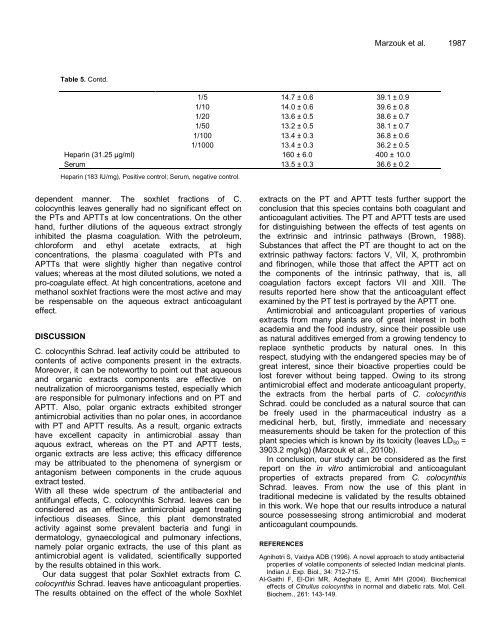Download Complete Issue (pdf 3800kb) - Academic Journals
Download Complete Issue (pdf 3800kb) - Academic Journals
Download Complete Issue (pdf 3800kb) - Academic Journals
You also want an ePaper? Increase the reach of your titles
YUMPU automatically turns print PDFs into web optimized ePapers that Google loves.
Table 5. Contd.<br />
1/5 14.7 ± 0.6 39.1 ± 0.9<br />
1/10 14.0 ± 0.6 39.6 ± 0.8<br />
1/20 13.6 ± 0.5 38.6 ± 0.7<br />
1/50 13.2 ± 0.5 38.1 ± 0.7<br />
1/100 13.4 ± 0.3 36.8 ± 0.6<br />
1/1000 13.4 ± 0.3 36.2 ± 0.5<br />
Heparin (31.25 µg/ml) 160 ± 6.0 400 ± 10.0<br />
Serum 13.5 ± 0.3 36.6 ± 0.2<br />
Heparin (183 IU/mg), Positive control; Serum, negative control.<br />
dependent manner. The soxhlet fractions of C.<br />
colocynthis leaves generally had no significant effect on<br />
the PTs and APTTs at low concentrations. On the other<br />
hand, further dilutions of the aqueous extract strongly<br />
inhibited the plasma coagulation. With the petroleum,<br />
chloroform and ethyl acetate extracts, at high<br />
concentrations, the plasma coagulated with PTs and<br />
APTTs that were slightly higher than negative control<br />
values; whereas at the most diluted solutions, we noted a<br />
pro-coagulate effect. At high concentrations, acetone and<br />
methanol soxhlet fractions were the most active and may<br />
be respensable on the aqueous extract anticoagulant<br />
effect.<br />
DISCUSSION<br />
C. colocynthis Schrad. leaf activity could be attributed to<br />
contents of active components present in the extracts.<br />
Moreover, it can be noteworthy to point out that aqueous<br />
and organic extracts components are effective on<br />
neutralization of microorganisms tested, especially which<br />
are responsible for pulmonary infections and on PT and<br />
APTT. Also, polar organic extracts exhibited stronger<br />
antimicrobial activities than no polar ones, in accordance<br />
with PT and APTT results. As a result, organic extracts<br />
have excellent capacity in antimicrobial assay than<br />
aquous extract, whereas on the PT and APTT tests,<br />
organic extracts are less active; this efficacy difference<br />
may be attribuated to the phenomena of synergism or<br />
antagonism between components in the crude aquous<br />
extract tested.<br />
With all these wide spectrum of the antibacterial and<br />
antifungal effects, C. colocynthis Schrad. leaves can be<br />
considered as an effective antimicrobial agent treating<br />
infectious diseases. Since, this plant demonstrated<br />
activity against some prevalent bacteria and fungi in<br />
dermatology, gynaecological and pulmonary infections,<br />
namely polar organic extracts, the use of this plant as<br />
antimicrobial agent is validated, scientifically supported<br />
by the results obtained in this work.<br />
Our data suggest that polar Soxhlet extracts from C.<br />
colocynthis Schrad. leaves have anticoagulant properties.<br />
The results obtained on the effect of the whole Soxhlet<br />
Marzouk et al. 1987<br />
extracts on the PT and APTT tests further support the<br />
conclusion that this species contains both coagulant and<br />
anticoagulant activities. The PT and APTT tests are used<br />
for distinguishing between the effects of test agents on<br />
the extrinsic and intrinsic pathways (Brown, 1988).<br />
Substances that affect the PT are thought to act on the<br />
extrinsic pathway factors: factors V, VII, X, prothrombin<br />
and fibrinogen, while those that affect the APTT act on<br />
the components of the intrinsic pathway, that is, all<br />
coagulation factors except factors VII and XIII. The<br />
results reported here show that the anticoagulant effect<br />
examined by the PT test is portrayed by the APTT one.<br />
Antimicrobial and anticoagulant properties of various<br />
extracts from many plants are of great interest in both<br />
academia and the food industry, since their possible use<br />
as natural additives emerged from a growing tendency to<br />
replace synthetic products by natural ones. In this<br />
respect, studying with the endangered species may be of<br />
great interest, since their bioactive properties could be<br />
lost forever without being tapped. Owing to its strong<br />
antimicrobial effect and moderate anticoagulant property,<br />
the extracts from the herbal parts of C. colocynthis<br />
Schrad. could be concluded as a natural source that can<br />
be freely used in the pharmaceutical industry as a<br />
medicinal herb, but, firstly, immediate and necessary<br />
measurements should be taken for the protection of this<br />
plant species which is known by its toxicity (leaves LD50 =<br />
3903.2 mg/kg) (Marzouk et al., 2010b).<br />
In conclusion, our study can be considered as the first<br />
report on the in vitro antimicrobial and anticoagulant<br />
properties of extracts prepared from C. colocynthis<br />
Schrad. leaves. From now the use of this plant in<br />
traditional medecine is validated by the results obtained<br />
in this work. We hope that our results introduce a natural<br />
source possessesing strong antimicrobial and moderat<br />
anticoagulant coumpounds.<br />
REFERENCES<br />
Agnihotri S, Vaidya ADB (1996). A novel approach to study antibacterial<br />
properties of volatile components of selected Indian medicinal plants.<br />
Indian J. Exp. Biol., 34: 712-715.<br />
Al-Gaithi F, El-Diri MR, Adeghate E, Amiri MH (2004). Biochemical<br />
effects of Citrullus colocynthis in normal and diabetic rats. Mol. Cell.<br />
Biochem., 261: 143-149.

















